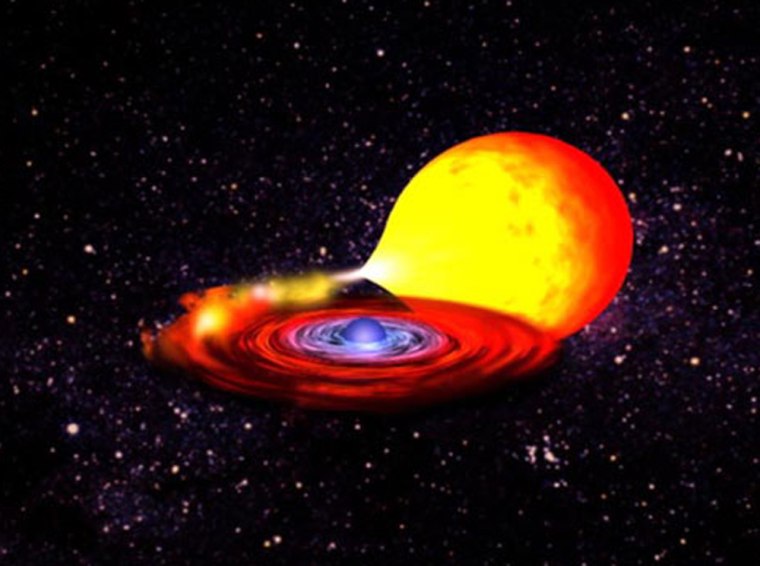Astronomers have snatched a peek at the innards of a neutron star, combining a series of observations to pin down the type of matter squeezed into the ultra-dense stellar ball.
The approach is expected to enable future astronomers to gain glimpses of the stuff inside other neutron stars and boost their understanding of matter, energy and the fundamental particles that make up the universe.
"Neutron stars are a sort of cosmic lab in a sense that the material at their centers is so dense it can't be reproduced on Earth," study leader Tod Strohmayer said in a telephone interview. "We can't get a piece of this material and examine it ourselves."
About the size of a city, a neutron star is the remnant of an exploded star whose matter is so compressed, the protons and electrons within its atoms fuse into neutrons. A teaspoon of the dense stuff would weigh about a billion tons on Earth.
Understanding the internal structure of a neutron star would allow scientists to determine the object's basic properties, explained Lars Hernquist, an astronomer with the Harvard-Smithsonian Center for Astrophysics who is unaffiliated with Strohmayer's study.
Seen in the Flying Fish
Strohmayer's star, part of a star system called EXO 0748-676, sits in the southern sky constellation Volans the Flying Fish, about 30,000 light-years away from Earth. One light-year is the distance light travels in a year, or roughly 6 trillion miles (10 trillion kilometers).
The neutron star has a radius of about 7 miles (11.5 kilometers) and a mass about 1.75 times that of the sun. It is also part of a binary system; it strips gas from a companion star and then blows the material outward in repetitive thermonuclear explosions.
Strohmayer, an astrophysicist at NASA's Goddard Space Flight Center in Greenbelt, Md., studied the neutron star with colleague and graduate student Adam Villarreal of the University of Arizona. The pair presented their research before the High Energy Astrophysics Division of the American Astronomical Society during a meeting last week in New Orleans.
Peering inside
The relationship between the size and heft of the EXO 0748-676 neutron star was a critical tool for researchers trying to determine is matter makeup.
"Knowing the mass and radius of these objects tells about the properties of matter inside the star," Strohmayer said, adding that the relationship between the two quantities can describe a star's internal pressure and density. "It tells you how the particles interact, the forces between fundamental particles and how much you can compress material."
But determining the dimensions of a neutron star is challenging.
"Measuring the radii of these stars is difficult because these things are very small," Hernquist told Space.com. "We can't image them directly."
Neutron stars in binary systems like EXO 0748-676 steal matter from their companions, then belch it out in explosions at frequencies related to their spin rates. The stellar burps can be detected by X-ray instruments.
Strohmayer and Villarreal used a relationship between their star's spin rate — 45 times per second — and the shift of its emissions to determine its radius, then plugged that number into a mass-radius ratio already known for the object to generate the mass.
The result, they say, is a detailed description of the state of matter inside a neutron star, where material is packed so tightly the neutrons swirl about in a frictionless superfluid. But the star is apparently not yet compressed to the point that its neutrons are smashed and their quarks — even tinier subentities — liberated into a so-called .
"At this point, it's too much to say a quark star is absolutely ruled out," Strohmayer said. "But we've squeezed out a lot of the parameters."
A wealth of data
One of the foundations for Strohmayer's approach was the availability of two orbiting X-ray facilities, each flush with observations of the EXO 0748-676 system.
Strohmayer and Villarreal used the space-based Rossi X-ray Timing Explorer to determine their neutron star's spin frequency, and archived data from the European Space Agency's XMM-Newton satellite for other measurements.
"It was partly used as a calibration source, where [researchers] stared at it for quite some time," Strohmayer said of the neutron star. "It takes a lot of data to make these measurements, and there have even been more recent observations on the star that researchers are still working with."
This neutron star spins quite slowly compared to similar objects -- which can range from 200 to 600 revolutions per second, researchers said. The leisurely 45-times-per second spin rate made it easier to capture the neutron star's emissions and split it into a spectra, much as visible light is separated in a prism. Analysis of a spectra yields insight into the material that emitted the various wavelengths.
Strohmayer hopes to refine and extend the method.
"We hope to do that and perhaps expand the number of neutron stars per spin frequency," he said. "But I think we can do a little better with [the current star's radius], so we'll do a little fine tuning."
